2009 FORD FUSION (AMERICAS) warning lights
[x] Cancel search: warning lightsPage 124 of 312
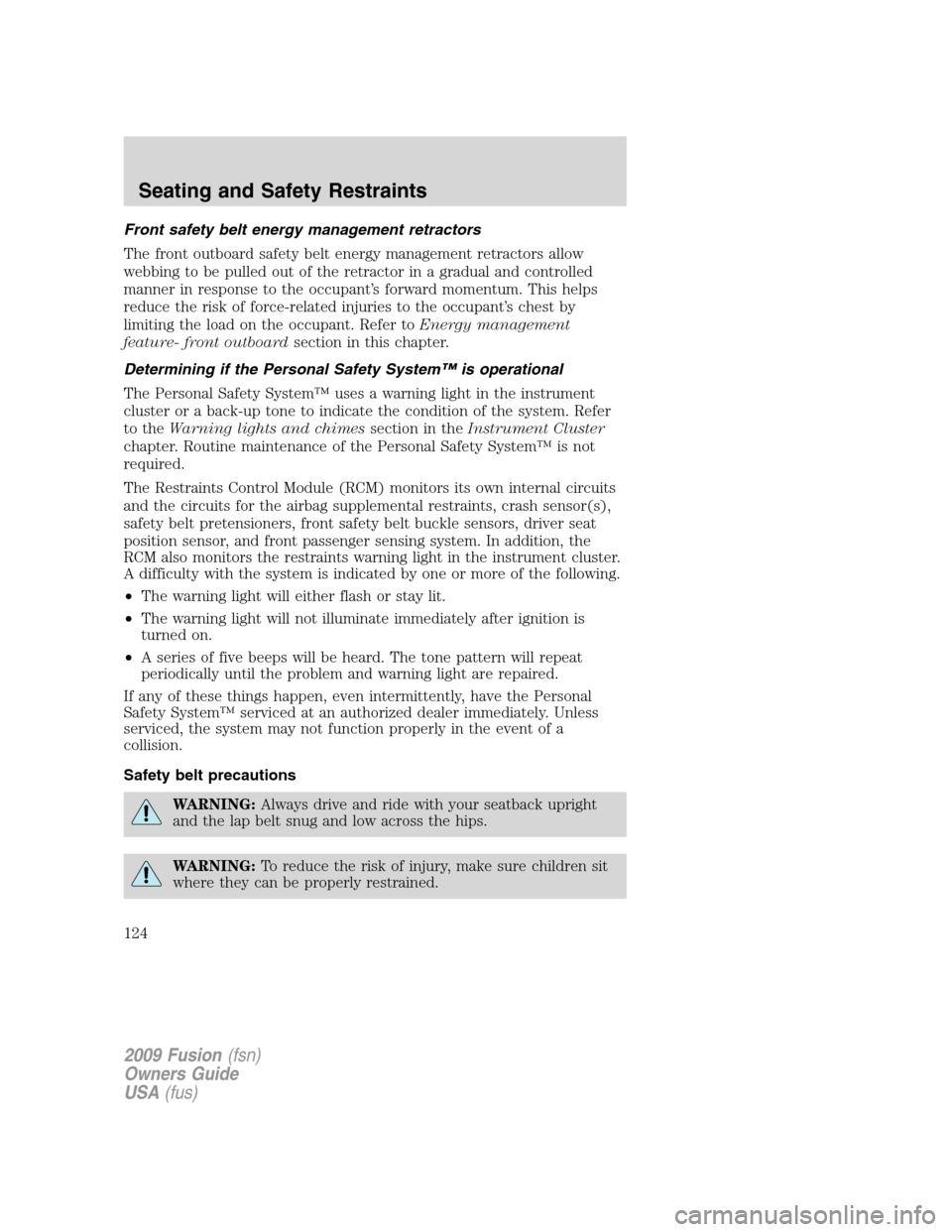
Front safety belt energy management retractors
The front outboard safety belt energy management retractors allow
webbing to be pulled out of the retractor in a gradual and controlled
manner in response to the occupant’s forward momentum. This helps
reduce the risk of force-related injuries to the occupant’s chest by
limiting the load on the occupant. Refer toEnergy management
feature- front outboardsection in this chapter.
Determining if the Personal Safety System™ is operational
The Personal Safety System™ uses a warning light in the instrument
cluster or a back-up tone to indicate the condition of the system. Refer
to theWarning lights and chimessection in theInstrument Cluster
chapter. Routine maintenance of the Personal Safety System™ is not
required.
The Restraints Control Module (RCM) monitors its own internal circuits
and the circuits for the airbag supplemental restraints, crash sensor(s),
safety belt pretensioners, front safety belt buckle sensors, driver seat
position sensor, and front passenger sensing system. In addition, the
RCM also monitors the restraints warning light in the instrument cluster.
A difficulty with the system is indicated by one or more of the following.
•The warning light will either flash or stay lit.
•The warning light will not illuminate immediately after ignition is
turned on.
•A series of five beeps will be heard. The tone pattern will repeat
periodically until the problem and warning light are repaired.
If any of these things happen, even intermittently, have the Personal
Safety System™ serviced at an authorized dealer immediately. Unless
serviced, the system may not function properly in the event of a
collision.
Safety belt precautions
WARNING:Always drive and ride with your seatback upright
and the lap belt snug and low across the hips.
WARNING:To reduce the risk of injury, make sure children sit
where they can be properly restrained.
2009 Fusion(fsn)
Owners Guide
USA(fus)
Seating and Safety Restraints
124
Page 144 of 312
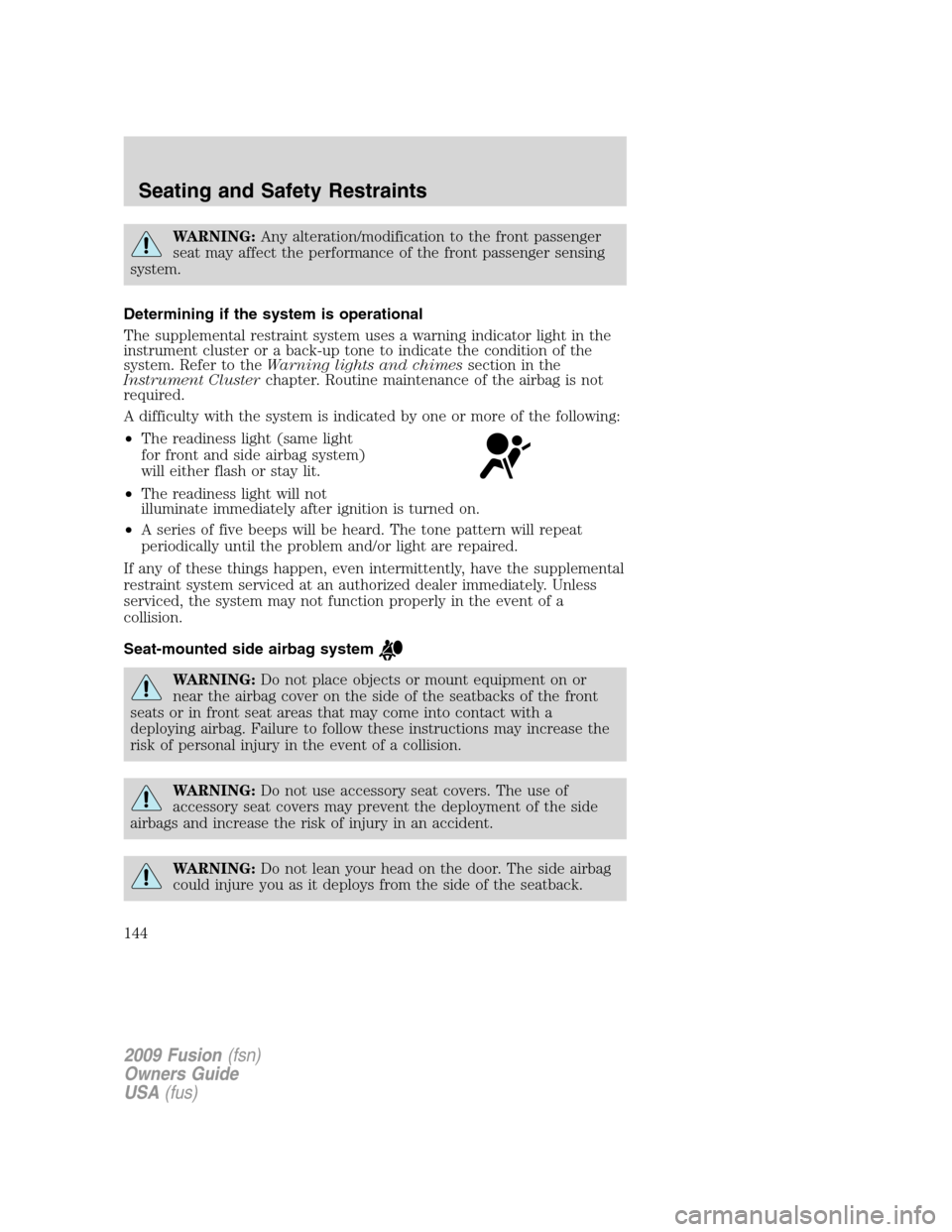
WARNING:Any alteration/modification to the front passenger
seat may affect the performance of the front passenger sensing
system.
Determining if the system is operational
The supplemental restraint system uses a warning indicator light in the
instrument cluster or a back-up tone to indicate the condition of the
system. Refer to theWarning lights and chimessection in the
Instrument Clusterchapter. Routine maintenance of the airbag is not
required.
A difficulty with the system is indicated by one or more of the following:
•The readiness light (same light
for front and side airbag system)
will either flash or stay lit.
•The readiness light will not
illuminate immediately after ignition is turned on.
•A series of five beeps will be heard. The tone pattern will repeat
periodically until the problem and/or light are repaired.
If any of these things happen, even intermittently, have the supplemental
restraint system serviced at an authorized dealer immediately. Unless
serviced, the system may not function properly in the event of a
collision.
Seat-mounted side airbag system
WARNING:Do not place objects or mount equipment on or
near the airbag cover on the side of the seatbacks of the front
seats or in front seat areas that may come into contact with a
deploying airbag. Failure to follow these instructions may increase the
risk of personal injury in the event of a collision.
WARNING:Do not use accessory seat covers. The use of
accessory seat covers may prevent the deployment of the side
airbags and increase the risk of injury in an accident.
WARNING:Do not lean your head on the door. The side airbag
could injure you as it deploys from the side of the seatback.
2009 Fusion(fsn)
Owners Guide
USA(fus)
Seating and Safety Restraints
144
Page 185 of 312
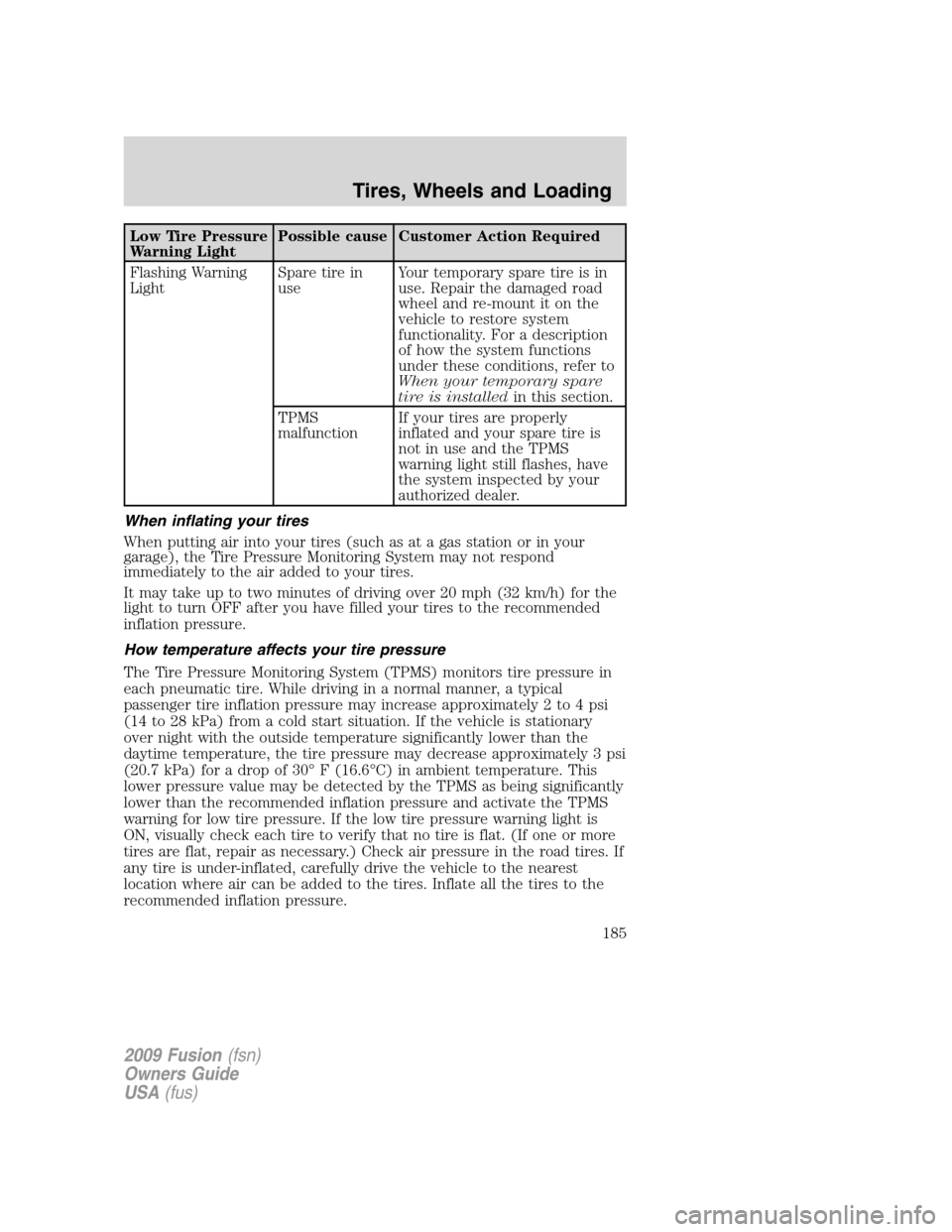
Low Tire Pressure
Warning LightPossible cause Customer Action Required
Flashing Warning
LightSpare tire in
useYour temporary spare tire is in
use. Repair the damaged road
wheel and re-mount it on the
vehicle to restore system
functionality. For a description
of how the system functions
under these conditions, refer to
When your temporary spare
tire is installedin this section.
TPMS
malfunctionIf your tires are properly
inflated and your spare tire is
not in use and the TPMS
warning light still flashes, have
the system inspected by your
authorized dealer.
When inflating your tires
When putting air into your tires (such as at a gas station or in your
garage), the Tire Pressure Monitoring System may not respond
immediately to the air added to your tires.
It may take up to two minutes of driving over 20 mph (32 km/h) for the
light to turn OFF after you have filled your tires to the recommended
inflation pressure.
How temperature affects your tire pressure
The Tire Pressure Monitoring System (TPMS) monitors tire pressure in
each pneumatic tire. While driving in a normal manner, a typical
passenger tire inflation pressure may increase approximately 2 to 4 psi
(14 to 28 kPa) from a cold start situation. If the vehicle is stationary
over night with the outside temperature significantly lower than the
daytime temperature, the tire pressure may decrease approximately 3 psi
(20.7 kPa) for a drop of 30° F (16.6°C) in ambient temperature. This
lower pressure value may be detected by the TPMS as being significantly
lower than the recommended inflation pressure and activate the TPMS
warning for low tire pressure. If the low tire pressure warning light is
ON, visually check each tire to verify that no tire is flat. (If one or more
tires are flat, repair as necessary.) Check air pressure in the road tires. If
any tire is under-inflated, carefully drive the vehicle to the nearest
location where air can be added to the tires. Inflate all the tires to the
recommended inflation pressure.
2009 Fusion(fsn)
Owners Guide
USA(fus)
Tires, Wheels and Loading
185
Page 193 of 312
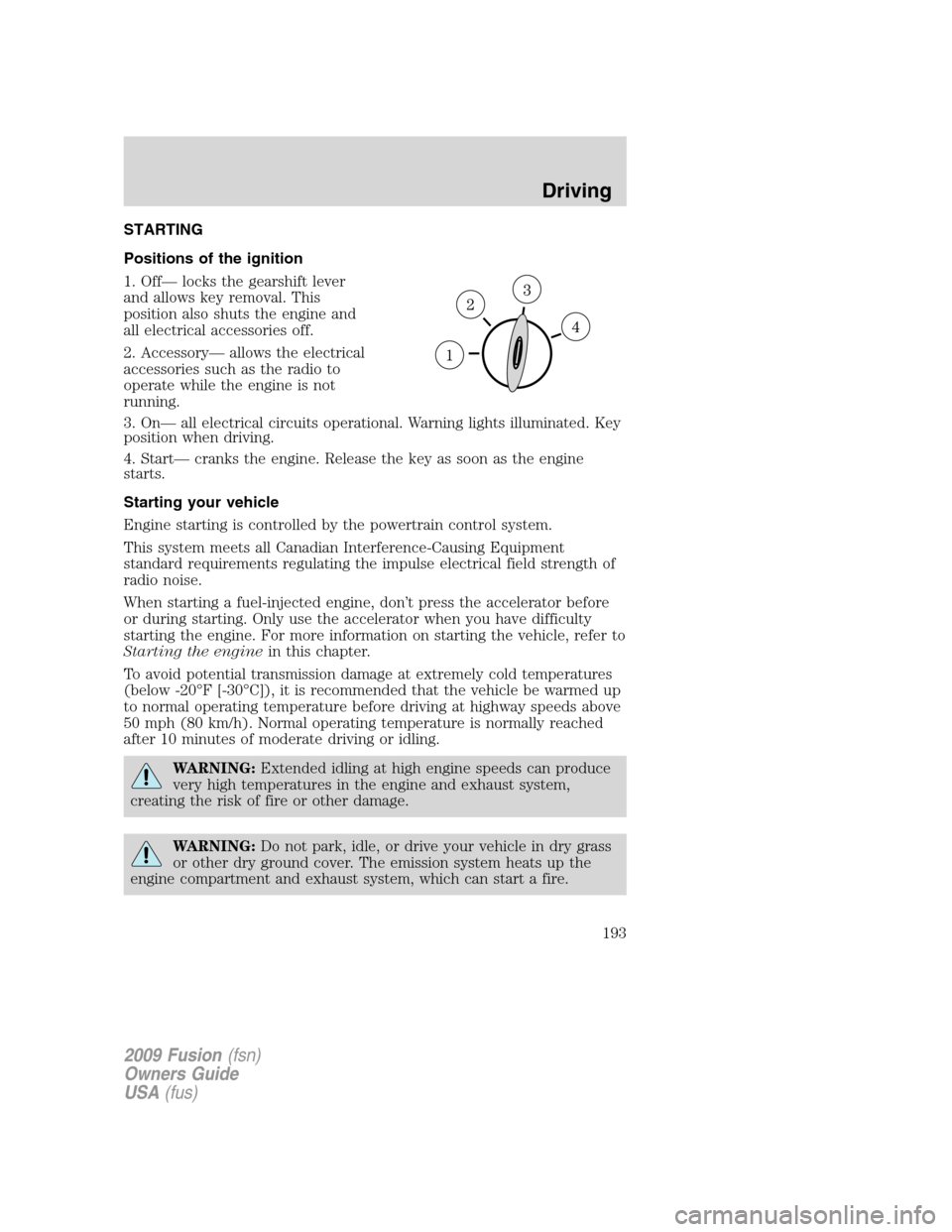
STARTING
Positions of the ignition
1. Off— locks the gearshift lever
and allows key removal. This
position also shuts the engine and
all electrical accessories off.
2. Accessory— allows the electrical
accessories such as the radio to
operate while the engine is not
running.
3. On— all electrical circuits operational. Warning lights illuminated. Key
position when driving.
4. Start— cranks the engine. Release the key as soon as the engine
starts.
Starting your vehicle
Engine starting is controlled by the powertrain control system.
This system meets all Canadian Interference-Causing Equipment
standard requirements regulating the impulse electrical field strength of
radio noise.
When starting a fuel-injected engine, don’t press the accelerator before
or during starting. Only use the accelerator when you have difficulty
starting the engine. For more information on starting the vehicle, refer to
Starting the enginein this chapter.
To avoid potential transmission damage at extremely cold temperatures
(below -20°F [-30°C]), it is recommended that the vehicle be warmed up
to normal operating temperature before driving at highway speeds above
50 mph (80 km/h). Normal operating temperature is normally reached
after 10 minutes of moderate driving or idling.
WARNING:Extended idling at high engine speeds can produce
very high temperatures in the engine and exhaust system,
creating the risk of fire or other damage.
WARNING:Do not park, idle, or drive your vehicle in dry grass
or other dry ground cover. The emission system heats up the
engine compartment and exhaust system, which can start a fire.
2009 Fusion(fsn)
Owners Guide
USA(fus)
Driving
193
Page 195 of 312
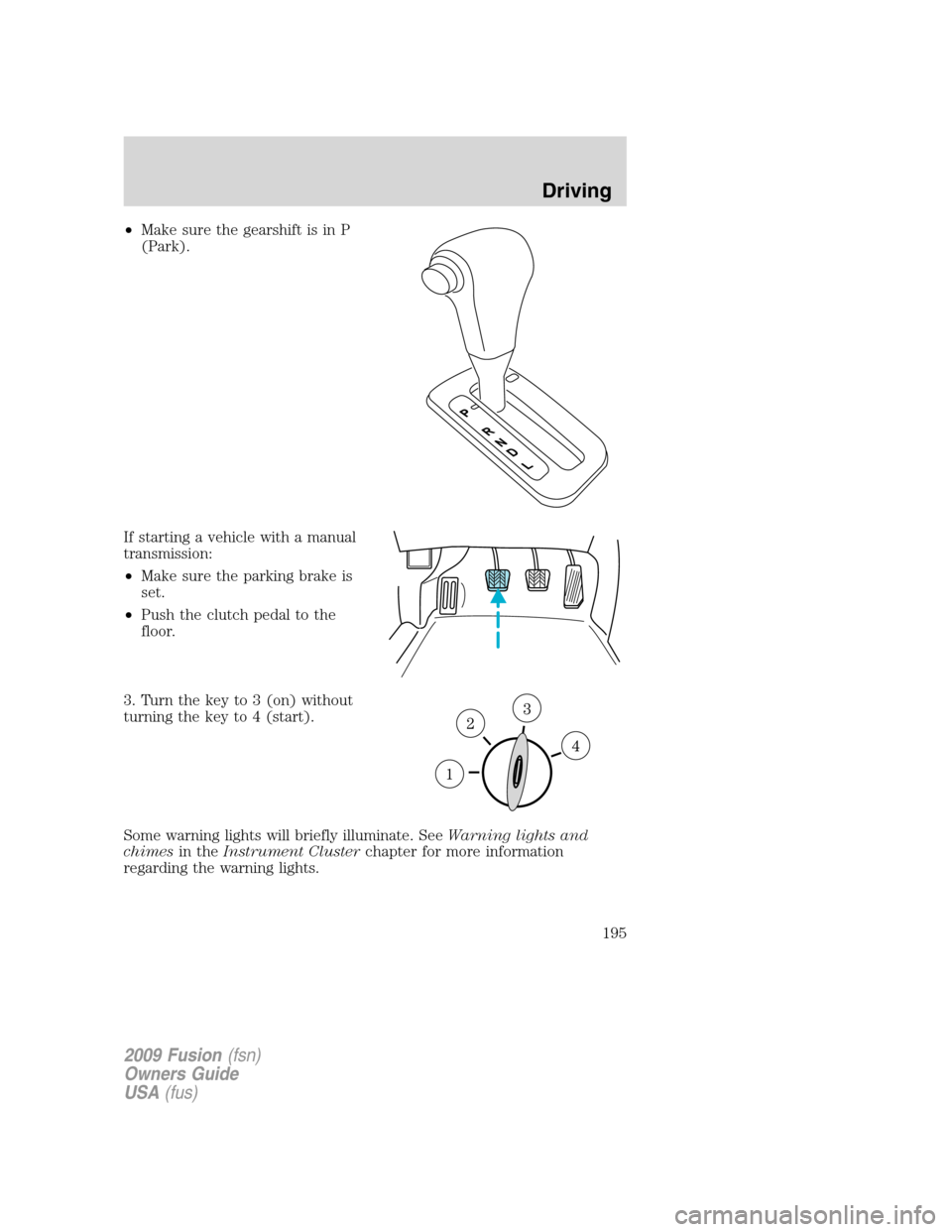
•Make sure the gearshift is in P
(Park).
If starting a vehicle with a manual
transmission:
•Make sure the parking brake is
set.
•Push the clutch pedal to the
floor.
3. Turn the key to 3 (on) without
turning the key to 4 (start).
Some warning lights will briefly illuminate. SeeWarning lights and
chimesin theInstrument Clusterchapter for more information
regarding the warning lights.
2009 Fusion(fsn)
Owners Guide
USA(fus)
Driving
195
Page 284 of 312
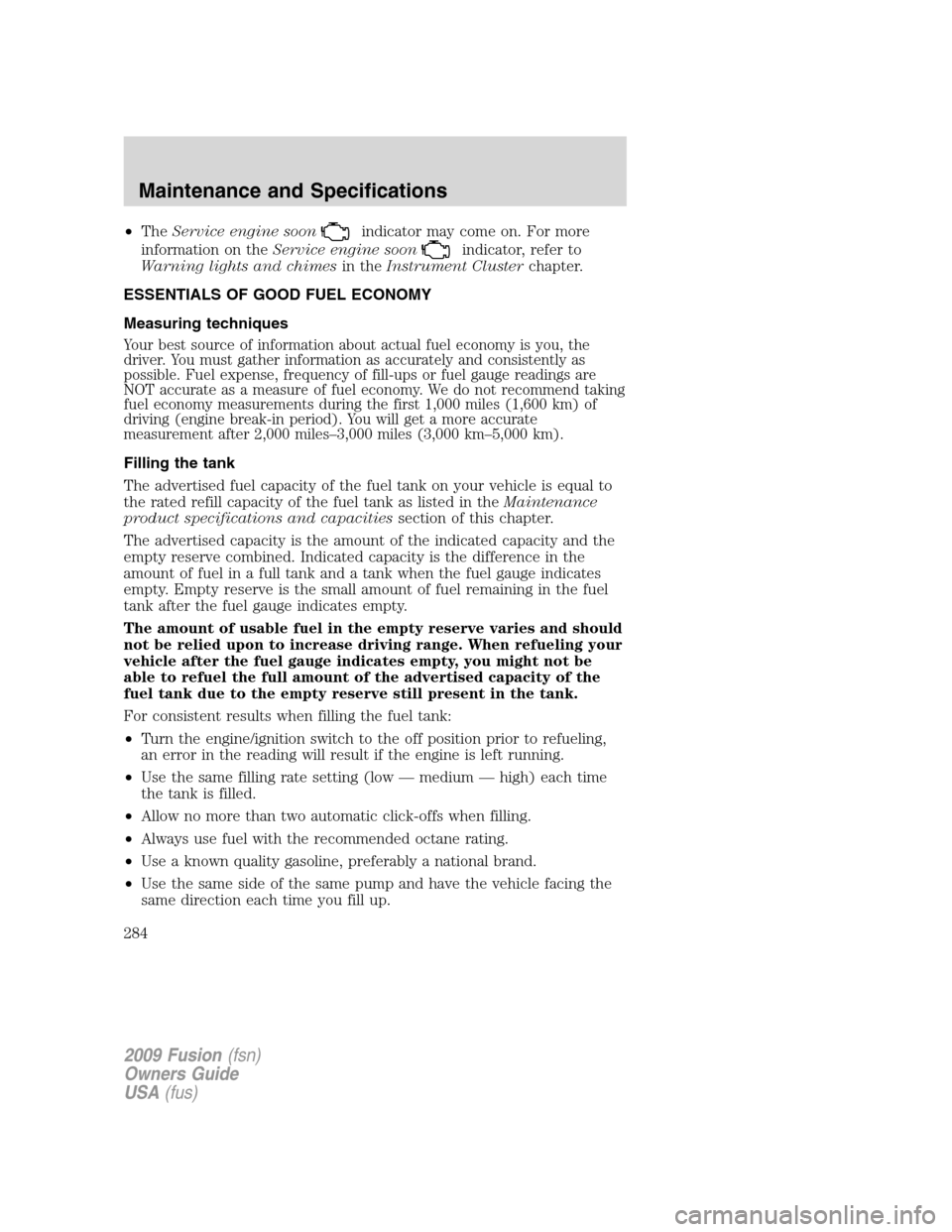
•TheService engine soonindicator may come on. For more
information on theService engine soon
indicator, refer to
Warning lights and chimesin theInstrument Clusterchapter.
ESSENTIALS OF GOOD FUEL ECONOMY
Measuring techniques
Your best source of information about actual fuel economy is you, the
driver. You must gather information as accurately and consistently as
possible. Fuel expense, frequency of fill-ups or fuel gauge readings are
NOT accurate as a measure of fuel economy. We do not recommend taking
fuel economy measurements during the first 1,000 miles (1,600 km) of
driving (engine break-in period). You will get a more accurate
measurement after 2,000 miles–3,000 miles (3,000 km–5,000 km).
Filling the tank
The advertised fuel capacity of the fuel tank on your vehicle is equal to
the rated refill capacity of the fuel tank as listed in theMaintenance
product specifications and capacitiessection of this chapter.
The advertised capacity is the amount of the indicated capacity and the
empty reserve combined. Indicated capacity is the difference in the
amount of fuel in a full tank and a tank when the fuel gauge indicates
empty. Empty reserve is the small amount of fuel remaining in the fuel
tank after the fuel gauge indicates empty.
The amount of usable fuel in the empty reserve varies and should
not be relied upon to increase driving range. When refueling your
vehicle after the fuel gauge indicates empty, you might not be
able to refuel the full amount of the advertised capacity of the
fuel tank due to the empty reserve still present in the tank.
For consistent results when filling the fuel tank:
•Turn the engine/ignition switch to the off position prior to refueling,
an error in the reading will result if the engine is left running.
•Use the same filling rate setting (low — medium — high) each time
the tank is filled.
•Allow no more than two automatic click-offs when filling.
•Always use fuel with the recommended octane rating.
•Use a known quality gasoline, preferably a national brand.
•Use the same side of the same pump and have the vehicle facing the
same direction each time you fill up.
2009 Fusion(fsn)
Owners Guide
USA(fus)
Maintenance and Specifications
284
Page 309 of 312

service points ..................262–263
starting after a collision .........223
Engine block heater .................196
Engine oil ..................................265
change oil soon warning,
message center .......................265
checking and adding ..............265
dipstick ....................................265
filter, specifications ........269, 297
recommendations ...................269
refill capacities ........................299
specifications ..........................299
Event data recording ....................6
Exhaust fumes ..........................196
F
Fail safe cooling ........................277
Fluid capacities .........................299
Foglamps .....................................54
Four-Wheel Drive vehicles
driving off road .......................215
Fuel ............................................279
calculating fuel
economy ............................83, 284
cap ...........................................281
capacity ...................................299
choosing the right fuel ...........282
comparisons with EPA fuel
economy estimates .................286
detergent in fuel .....................283
filling your vehicle with
fuel ...........................279, 281, 284
filter, specifications ........278, 297
fuel pump shut-off switch .....223
improving fuel economy ........284
octane rating ...................282, 302
quality ......................................283
running out of fuel .................283safety information relating to
automotive fuels .....................279
Fuel pump shut-off switch .......223
Fuses ..................................223–224
G
Gas cap (see Fuel cap) ............281
Gas mileage
(see Fuel economy) .................284
Gauges .........................................14
H
Hazard flashers .........................222
Headlamps ...................................53
aiming ........................................56
autolamp system .......................53
bulb specifications ....................59
daytime running lights .............54
flash to pass ..............................55
high beam .................................55
replacing bulbs .........................60
turning on and off ....................53
Heating
heating and air conditioning
system ...........................45, 47, 49
Hood ..........................................261
How to get going ........................17
I
Ignition ...............................193, 302
Illuminated visor mirror .............69
Infant seats
(see Safety seats) .....................154
Inspection/maintenance (I/M)
testing ........................................289
2009 Fusion(fsn)
Owners Guide
USA(fus)
Index
309
Page 310 of 312

Instrument panel ........................71
cleaning ...................................256
cluster ........................................10
lighting up panel and
interior .......................................55
J
Jack ............................................230
positioning ...............................230
storage .....................................230
Jump-starting your vehicle ......236
K
Keyless entry system ...............105
autolock .....................................94
keypad .....................................105
locking and unlocking doors ..106
programming entry code .......105
Keys .....................................91, 108
positions of the ignition .........193
L
Lamps
autolamp system .......................53
bulb replacement
specifications chart ..................59
daytime running light ...............54
fog lamps ...................................54
headlamps .................................53
headlamps, flash to pass ..........55
instrument panel, dimming .....55
interior lamps ...........................57
replacing bulbs .........................60
LATCH anchors .........................157
Lights, warning and indicator ....10
anti-lock brakes (ABS) ..........199
Load limits .................................187Locks
autolock .....................................94
childproof ..................................97
doors ..........................................93
Lubricant specifications ...........299
Lug nuts ....................................235
Lumbar support, seats .............115
M
Manual transmission .................211
fluid capacities ........................299
lubricant specifications ..........299
reverse .....................................212
Message center .....................81–82
english/metric button ...............87
system check button ................86
warning messages .....................88
Mirrors ...................................74–75
automatic dimming rearview
mirror ........................................74
heated ........................................75
side view mirrors (power) .......75
Moon roof ....................................80
Motorcraft parts ........259, 278, 297
N
Navigation system .......................44
O
Octane rating ............................282
Oil (see Engine oil) ..................265
P
Parking brake ............................199
Parts (see Motorcraft parts) ....297
2009 Fusion(fsn)
Owners Guide
USA(fus)
Index
310